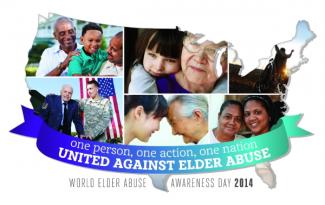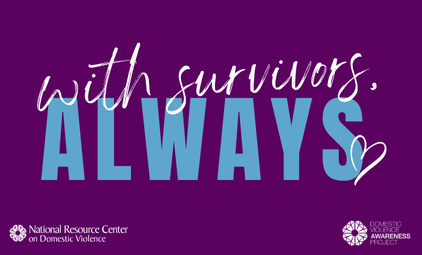The term elder abuse refers to any physical, sexual, or psychological abuse, neglect, abandonment, or financial exploitation of an older person either within a relationship where there is an expectation of trust and/or when an older person is targeted based on age or disability (U.S. DOJ, 2013). Research estimates that approximately one in ten older adults living in their homes experience elder abuse each year (Acierno et al., 2010; Beach et al., 2010; Lifespan of Greater Rochester et al., 2011).
At the National Resource Center on Domestic Violence (NRCDV), we call attention to abuse in later life, perpetrated by someone in an ongoing intimate relationship with the victim, and provide resources to prevent and address domestic and sexual violence against older adults. Read more about theterms and considerations related to elder abuse from the National Clearinghouse on Abuse in Later Life (NCALL), a proud partner in our work to help build an effective community-based response to gender based violence.
On June 15, 2014, for World Elder Abuse Awareness Day, the Administration for Community Living (ACL), encourages individuals and organizations across our nation, states, territories and local communities to take a stand and to raise public awareness about elder abuse by utilizing the resources in their comprehensive toolkit. NCALL also offers helpful ideas and resources for raising awareness on June 15th and throughout the year.
This year’s theme reminds us that it only takes one individual, one action, to make a difference.
ABUSE IN LATER LIFE

Preventing and Responding to Domestic & Sexual Violence in Later Life (Updated May 2014)
INTRODUCING PREVENTIPV

The PreventIPV project provides an opportunity to create and sustain a unified national prevention effort by promoting strategies, tools and lessons learned by state/territory and community-based prevention programs across the United States.
You are invited to explore and engage in the the newly launched PreventIPV.org online space, offering peer-driven resources and tools to support your prevention work.
- Access and subscribe to the PreventIPV Newsletter.
- Join the #PreventIPV Twitter Chat on June 18th.
- Register for the PreventIPV Web Conference on June 23rd.
ADVOCATE-DOULA PARTNERSHIP AND SUPPORT FOR PREGNANT SURVIVORS

It provided a wealth of resources for us to start making connections on the local level. The webinar is useful as we expand our hospital advocacy for sexual assault survivors to include DV survivors presenting to the Emergency Department and Labor and Delivery.” – A Healthcare Professional
I will be more vigilant for signs of DV and make it a point to inquire about past and current experiences in order to enhance the level of service I provide. I will also be better prepared to refer to community resources that could help the family.” – A Birth Doula
Access all associated files through VAWnet here.
AEDVC LEADERSHIP FORUM

Childhood Exposure to Violence Prevention and Awareness Week (April 21-27) marked the launch of an important new national initiative representing the voices and perspectives of adults who experienced domestic violence in childhood (AEDVC). Comprised of local, state and national advocates in the movement to end gender based violence who identify as AEDVC, the Leadership Forum envisions a movement that includes their perspectives and priorities in the provision of services, the development of policies, the direction of research and the general approach to effectively address and prevent domestic violence. Learn more here and follow the initiative on Facebook for updates and related information.
HELPING YOUNG CHILDREN THRIVE

Essentials for Parenting Toddlers and Preschoolers by the Centers for Disease Control and Prevention (2014)
This new evidence-based online resource from the CDC offers tools for parents to build safe, stable, and nurturing relationships with their young children.
TA QUESTIONS OF THE MONTH
![]()
Read and comment on these recent requests received by theNational Sexual Violence Resource Center and National Resource Center on Domestic Violence!
June 2014: How can I enhance the capacity of college students to respond to sexual assault?
Many organizations and colleges have resources and plans in place to take on this issue. Some of our personal favorites highlight the voices and experiences of students, keeping the real focus of these strategies – a healthy, safe campus for all – front and center. Read on.
May 2014: What are some best practices for serving deaf survivors of gender based violence?
Effective interventions to address gender based violence within the Deaf community require, at the very least, ongoing training and education about Deaf culture, collaboration between the Deaf community and hearing allies, the development of appropriate policies and procedures, and the continued implementation of linguistically and culturally responsive services. Read on.
NEW ON VAWNET
Recent additions to the VAWnet library include:
Understanding Elder Abuse: New Directions for Developing Theories of Elder Abuse Occurring in Domestic Settings by Shelly L. Jackson and Thomas L. Hafemeister for the National Institute of Justice (June 2013)
Domestic Violence In Context: Unmet Needs and Promising Strategies by Jill Groblewski for the Center for Family Policy & Practice (March 2013)
Images, Consent, & Abuse by the Safety Net Project of the National Network to End Domestic Violence (2014)
Making Asset Building Accessible to Survivors of Domestic Violence: A Toolkit by Bradley Angle (2014)
Why Prevention? Why Now? by Joan Tabachnik for the International Journal of Behavioral Consultation and Therapy (2013)
Helping Foster and Adoptive Families Cope with Traumaby Heather C. Forkey, Andrew S. Garner, John Stirling, Samantha Schilling, and Lisa Nalven for the American Academy of Pediatrics (2013)
Violence Through the Lens of Lesbians, Bisexual Women and Trans (LBT) Individuals in Asia by the The International Gay and Lesbian Human Rights Commission (IGLHRC) (May 2014)
Intersection of Intimate Partner Violence and HIV in Women by the Centers for Disease Control and Prevention, National Center for Injury Prevention and Control (February 2014)
Community Action Toolkit for Addressing Intimate Partner Violence Against Transgender People by NCAVP with GLAAD, the National Black Justice Coalition, National Center for Transgender Equality, Trans People of Color Coalition, and National Gay and Lesbian Task Force (April 2014)
Not Alone: The First Report of the White House Task Force to Protect Students from Sexual Assault from The White House (April 2014)















